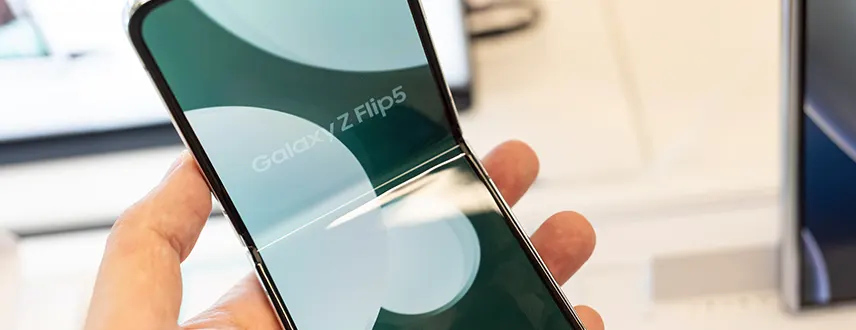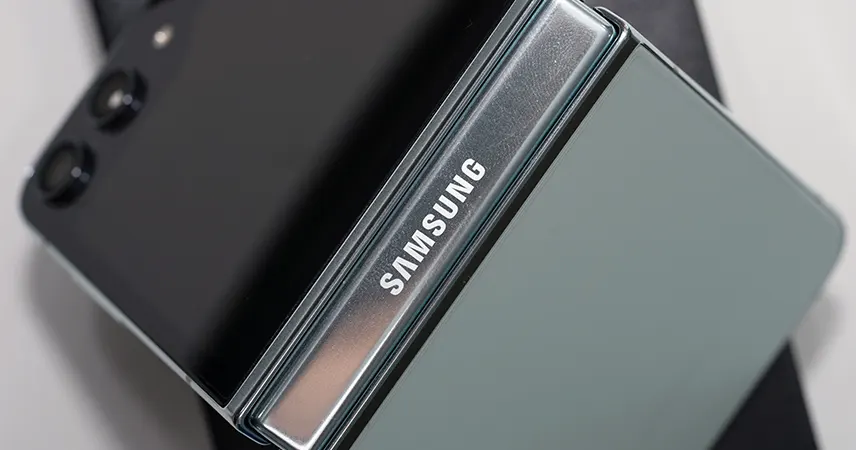Samsung Galaxy Z Flip 5 Review
 By Jonathan Owen
By Jonathan Owen Marketing Manager
Published
21st August 2023
Last modified 23rd October 2024
Last modified 23rd October 2024
loveit? shareit!

In the ever-evolving world of foldable smartphones, the Samsung Galaxy Z Flip 5 stands out with its fifth-generation iteration, showcasing small yet impactful improvements that enhance its usability and appeal. Priced at £1,049 ($999/A$1,649), this flip phone offers a larger external screen, refined design, and notable upgrades that bring it in line with the premium Android and iPhone counterparts. Take a dive into the various aspects of the Galaxy Z Flip 5 to see how it fares in this tech review brought to you by the loveit coverit phone insurance team.
Samsung has refined the design of the Galaxy Z Flip 5, giving it a more sophisticated and sleek appearance. The new hinge design ensures a flush closure, eliminating the unsightly gap that was present in previous models. This not only adds to the aesthetics but also prevents debris from entering the device. The device’s overall slimness is a result of this design change, making it comfortable to carry in pockets without being obstructive. The slightly reduced crease size on the screen further contributes to an improved visual experience.
The Galaxy Z Flip 5 boasts a vibrant 6.7-inch FHD+ AMOLED Infinity Flex Display that’s a delight to use. The screen is notably brighter, crisper, and smoother, offering an immersive viewing experience. Samsung’s claims of improved durability hold up, but it’s essential to treat the screen with care due to its softer material composition. The 3.4-inch AMOLED cover screen on the exterior is a standout feature, displaying notifications and even accommodating app use without needing to unfold the phone. The quick settings panel is convenient, although customization options are lacking.

galaxy z flip5 outside
The device is powered by the Qualcomm Snapdragon 8 Gen 2 processor, providing snappy performance that competes with top-tier smartphones. With 8GB of RAM and storage options of 256GB or 512GB, multitasking and storage needs are well addressed. The One UI 5.1 software, based on Android 13, enhances the user experience with refinements and unique features like “Flex Mode,” which optimizes apps for the folding configuration.
The Galaxy Z Flip 5’s battery life is commendable, lasting around 35 hours between charges. It’s notably better than its predecessor, but still, daily charging might be necessary for heavy users. The 90-minute full charge time and 30-minute 50% charge time using a 25W charger are quite reasonable.
Samsung takes steps toward sustainability by using recycled materials and offering trade-in and recycling programs. The phone’s repairability is also a plus, with replaceable batteries and screen repair options. The availability of self-repair programs and accidental damage insurance reduces the cost of potential repairs.
While the Galaxy Z Flip 5’s camera setup doesn’t deviate much from its predecessor, the dual 12-megapixel rear cameras and 10-megapixel front-facing camera deliver solid performance. Night photography and overall image quality have seen slight improvements, although the lack of optical zoom is a limitation. The exterior screen can be used for selfie photography, enhancing results across different lighting conditions.
Priced at £1,049 ($999/A$1,649), the Galaxy Z Flip 5 competes with other folding phones like the Galaxy Z Fold 5, Google Pixel Fold, Oppo Find N2 Flip, and Motorola Razr 40 Ultra. While not the most affordable option, the device justifies its price with its premium design and features.
The Samsung Galaxy Z Flip 5 marks a significant step forward for foldable technology. With refined design elements, a useful external cover screen, and impressive software support, it manages to offer a more mature product compared to its predecessors. While it’s not the only foldable flip phone available, the Galaxy Z Flip 5 distinguishes itself as the best on the market. It’s a compelling choice for those seeking a blend of innovation and practicality in their smartphone experience.
Pros:
Cons: